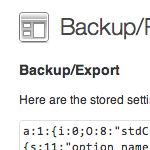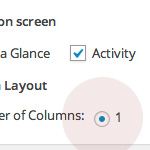Posts categorized: Theme

How to Prevent Changes to Plugins, Themes, and WordPress Core Files
This is a common question I get from folks in the WordPress community. How can I “lock things down” and prevent any changes to plugins, themes, and WordPress core files. For example, how to prevent any themes and/or plugins from being updated or deleted, and how to prevent any new plugins from being installed. This is useful for certain projects where it’s necessary to lock a website to a static version. Fortunately, WordPress makes this super easy with a couple of PHP constants. Let’s take a quick look..

The Difference Between Taxonomies, Categories, and Tags (Oh My!)
A common question for new WordPress users is, “what’s the difference between categories and tags?” Like everyone knows what a “category” is, but the idea of “tags” can seem very similar. And then you throw in related WordPress concepts like “taxonomy”, and things can get confusing very quickly. But no worries, it’s really not that complicated. Let’s break it down..

How to Disable Gutenberg Styles on the Frontend
By default the Gutenberg Block Editor loads its default CSS/stylesheet on the front-end of your WordPress site. This is fine for most cases, but there may be situations where you want to disable the Gutenberg styles for whatever reason. For example, my free WordPress plugin, Disable Gutenberg, enables users to disable the Gutenberg Block Editor and restore the Classic Editor. Included in the plugin settings is an option called “Enable Frontend” that lets users enable or disable the Gutenberg CSS/styles as desired. This quick DigWP tutorial explains programmatically how to disable Gutenberg styles on the front-end.

How to Check if Post has Taxonomy Term
Something I did not know about when working with Custom Post Types and Custom Taxonomies. Normally when checking if a regular WP Post belongs to a specific category, we can use the WordPress function in_category(). But that does not work with Custom Post Types. To check if a CPT belongs to a specific term in a Custom Taxonomy, use has_term() instead.

How to Add Custom Content to WordPress Feeds
There are numerous ways to add custom content to your WordPress feeds. If you’re not using a plugin, it’s possible to just add a code snippet to your theme’s functions.php file. For most cases, I think probably going the plugin route is the easiest way to add custom content to your WordPress RSS/feeds. Just install, activate, add your content and done. But for WordPress developers and designers who want more fine-grained control, this article explains how to add custom feed content programmatically using the WP API. So whether you need to add copyright text, advertisements, hyperlinks, or virtually anything at all, this post explains how to make it happen.

Display Your WordPress Site Statistics: Complete Guide
Just to be crystal clear, this post is all about displaying basic statistics about your site, not about your visitors. So if you are thinking something like, “duh, just use Google Analytics or whatever,” then imagine a giant buzzer sound telling you that you’re incorrect. Sure, Google Analytics gives you information about your visitors, like how many, where from, how long, and so forth. But GA et al do NOT provide information about your site itself. Things like the number of registered users, number of posts and pages, number of comments, and all the other cool little details about your site. That is what we’ll be covering in today’s DigWP tutorial. So grab some popcorn and enjoy the show! ;)

DigWP Theme Updates!
Quick post to announce updates for all DigWP themes, free and exclusive. All of our themes are current with the latest version of WordPress, and include lots of new features, bug fixes, and enhancements. 100% ready for action :)
The free themes are all free and open-source for everyone, and the exclusive themes are included with purchase of Digging Into WordPress. If you own the book, you can log in and download the updated themes in the DigWP Members Area, at your convenience. Now let’s check ’em out..

How to Include Styles in WordPress Child Themes
This DigWP tutorial explains the “new” way to include parent stylesheets in Child Themes. I put the word “new” in quotes because the technique actually has been around for years, but there are many developers and designers who still use the old @import way of adding parent styles. This tutorial is for people who may be unfamiliar with using WordPress’ enqueue functionality for Child Themes.
Here you’ll find copy-n-paste techniques, examples, caveats, and numerous resources. Basically everything you need to know about including styles in your Child Themes. Let’s dig in..

WordPress Themes In Depth
Super stoked to announce my new book, WordPress Themes In Depth! It covers the entire process of setting up, development, distribution, and everything in between.
WordPress Themes In Depth is literally overflowing with over 450 pages of in-depth theme-building action. And it includes example themes and lots of project demos. If you want to develop, customize, and even sell your own awesome WordPress themes, you’re gonna benefit greatly from this book.

WordPress Backup and Restore Theme Options
After taking the time to set a whole bunch of theme options, it’s nice to be able to make a quick backup of your theme settings. Many themes have this functionality built-in, but for themes that don’t, here is a plug-n-play snippet to create a “Backup/Restore Theme Options” page. You can see the technique in action in my shapeSpace theme (100% free and open-source WordPress starter theme).

H5 Theme Update
Theme update! The H5 Starter Theme is all updated and afresh for your theme-building adventures. The previous version of H5 still works great, but there was a lot of room for improvement, especially with all of the new features and functionality made available in recent versions of WordPress. So now the H5 starter theme is better than ever and as always 100% free download for everyone.

Bring Back Single-Column Dashboard
After updating to WordPress 3.8, the single-column Dashboard disappears with no options to bring it back. For years, users could set the number of columns in the Dashboard to suit their needs, but apparently some brilliant decision was made to just remove it. Personal opinions and feelings aside, here is a quick snippet to bring back single-column Dashboard layout for those who were using it and wish to continue doing so.

Post Format Archives Widget
Custom Post Formats enable you to customize your asides, images, and other types of posts. Doing so is a great way to bring character and definition to an otherwise amorphous collection of regular posts. Then, as your custom-formatted posts grow in number, your site will feature uniquely styled archives for each of your Custom Post Formats.

Find the Perfect Theme
I’ve been working with WordPress for about 2 years now. I’ve set up dozens of websites for both myself and clients and finding the perfect theme has always been a bit of a chore. Don’t get me wrong, I love that there are so many to choose from, but now that there are over 100 companies that make WordPress themes outside of the big market places like TemplateMonster and ThemeForest I quickly got tired of clicking through all of them to find the perfect theme.







